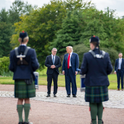Voters are volatile. The two party system has suffered a two-pronged attack. Social media campaigns are bigger, with more micro-targeting. Fake news is on the rise. Many MPs have resigned, making it easier for challenger parties in their seats. Former cabinet ministers are standing as independents. There isn’t just one national election, but 650 different contests. Many constituencies will have close results, as the fragmentation of the vote means some candidates will win with less than a third of the vote. So, some say, this is the most unpredictable election... ever!
Haven’t we heard much of this before? Wasn’t the two-party system under attack in 2015? Weren’t there big changes in vote intention during the campaign in 2017, and 2010 for that matter? So is this really the most unpredictable election ever? Yes, yes, yes and no.
For an election to be predictable we need to have confidence in a forecasting method with sufficient accuracy. What is sufficient depends on what’s being asked. For the most crucial question of who gets to govern, more precision will be needed if the election is close. Conversely, it doesn’t matter much to most people if forecasters get the scale of a landslide wrong, so long as they identify the right party winning big.
In that sense we can’t (yet) predict the outcome of this election with much confidence. The Conservative lead over Labour in the polls is narrower than what it was at the same stage before the 2017 election. A lot changed in the final month last time, so we can’t rule out the possibility that opinion will change dramatically before polling day. That’s not to say that we should expect the same pattern of change, or any change at all. But many voters have already switched their votes and vote intentions at some point since 2017. Even if nothing changes between now and election day, this will still—by the traditional measure of change since the last election—be one of the most volatile elections on record.
Many pundits were overconfident about the chances of a Tory landslide in 2017. They are not making the same mistake again. But that’s not much protection against making a different mistake; it could even raise the risk of that.
The overconfidence last time round reflected the presumption that campaign periods don’t produce much change. Actually there’s usually a change of at least a couple of points for one or both of the main parties in the final month, but it is not memorable since it rarely changes the character of the result. The 2015 campaign polls were especially flat, and many drew the wrong lesson from the failure of the Liberal Democrats to win any extra seats in 2010. Cleggmania, they concluded, didn’t really happen. Actually the Lib Dems ended the campaign a massive eight points higher in the polls than when they started.
Risk of systematic polling error, of the kind that we only discover when the results come in, is another reason why it is hard to predict elections. While the average of the polls at the moment is pointing to a comfortable Tory majority of around 56, if there is a polling miss of the scale we saw in 2015 and 1992, but to Labour’s advantage, then the Tories would be short of a majority by nine seats.
Last time one or two pollsters got close to the eventual result in the end, so we might hope this will happen again, but it’s not much use if we don’t know which one or two polls it will be in advance. So the question is whether polling might have learned the lessons and got better? Don’t bank on it: international research by Will Jennings and Christopher Wlezien has shown that polls have not been getting systematically better or worse around the world, they just haven’t been very precise for many years.
What about all the complexities of constituency contests between different parties in different parts of Britain? Don’t they make national vote-intention polls useless and make this election unpredictable? Perhaps it will turn out like that, but historically constituency variation, while it exists, hasn’t mattered that much for headline seat outcomes.
Traditional uniform change seat projections, where vote shares are assumed to rise and fall by the same amount in all constituencies, are criticised for being overly simplistic. The old swingometer uses uniform change, but just for the two main parties. Not only do we need to consider changes for all parties, but at least since the independence referendum we need to allow for different changes in Scotland from those in England and Wales. If we do that then the table below shows how uniform change projections using actual overall vote shares come pretty close to the actual seat tallies, especially in the supposedly wild case of 2017 where these uniform predictions get within five seats for all parties.
The particular seats won and lost by each party are much less accurately predicted by uniform change: small towns might move one way, cities another, the northwest might be in a grumpier mood than the south, and indeed as I showed for Prospect just after the 2017 vote Leaveland and Remainia could move in very different ways. But, since not all swings can be bigger than average, movements by one group must be balanced by another when considered relative to the overall change. Similarly, but not always (since geography can matter), the effects on seat tallies of different swings in different places often cancel each other out. The overall numbers which determine who governs are much as they would be if you extended an old-fashioned swingometer to include all the parties and applied it across Scotland, and across England and Wales as a whole.
What this means is that if the opinion polls correctly anticipated the shares of the vote on both sides of the border, then uniform change projections would have provided excellent guides to the outcomes of these elections, much better than published forecasts at the time.
With closely balanced arithmetic in parliament, even small discrepancies can have big political effects. Had the Tories won 320 seats in 2015 that would have left David Cameron without the majority he actually achieved. The crucial additional 11 seats were almost all due to first-term incumbency bonuses for Tory MPs initially elected in 2010 and fighting for re-election. So sometimes local variation can matter.
But perhaps the most remarkable feature of the table is how close the uniform change projection for 2015 comes to the actual number of Liberal Democrat MPs. At that election the party’s vote share fell by 16 points, two-thirds of what they had started with in 2010. Now a uniform drop of 16 points simply wasn’t arithmetically possible: in 170 constituencies the party did not even start with 16 per cent of the vote to lose. The crude assumption of uniform change is exposed, and in practice of course, they fell somewhat further where they started stronger. But a more intuitive prediction model, based on a proportional fall of two-thirds of their original vote in every seat would have seen them lose all their seats. For all its obvious crudity, the assumption of uniform movement in percentage points turned out to predict the national tally of seats remarkably well, even through a truly shocking collapse in support.
Now, 2019 really could be an election in which uniform change projections of seat tallies fail dismally, but nothing in recent British experience points to dismissing them out of hand.
It is also not ideal to rely on them. But since constituency polls are expensive and subject to all the usual polling problems, predicting constituency variation has often been impractical. However, at the last election YouGov’s multilevel regression and post-stratification (MRP) model did a good job of predicting both the pattern of change across constituencies and the eventual seat tally. What MRP involves is linking individual-level polling data with information about constituencies, building a statistical model summarising the linked data and projecting that model on to population profiles of each constituency. Others are now experimenting with MRP and related techniques. How well they will do remains to be seen. Model specification and the data quality are vital to success. But at least we know it can be done well and there’s scope and hope for still further improvement.
For all the problems of opinion polls, we know quite a lot about the chances of different outcomes thanks to them. Elections were surely harder to predict before opinion polls, so 2019 is definitely not the most unpredictable election ever. It is not even clear that this election is more unpredictable than the 2015 election was. Then Ukip were on the rise, the Lib Dems were collapsing, and the polls showed the two main parties neck-and-neck, apparently heading to a hung parliament. Perhaps the main thing that makes this election feel more unpredictable is a healthy dose of caution about the stability of public opinion and the accuracy with which it is measured.
Correction: this piece has been edited to remove an earlier erroneous reference to the uniform swing table
Haven’t we heard much of this before? Wasn’t the two-party system under attack in 2015? Weren’t there big changes in vote intention during the campaign in 2017, and 2010 for that matter? So is this really the most unpredictable election ever? Yes, yes, yes and no.
For an election to be predictable we need to have confidence in a forecasting method with sufficient accuracy. What is sufficient depends on what’s being asked. For the most crucial question of who gets to govern, more precision will be needed if the election is close. Conversely, it doesn’t matter much to most people if forecasters get the scale of a landslide wrong, so long as they identify the right party winning big.
In that sense we can’t (yet) predict the outcome of this election with much confidence. The Conservative lead over Labour in the polls is narrower than what it was at the same stage before the 2017 election. A lot changed in the final month last time, so we can’t rule out the possibility that opinion will change dramatically before polling day. That’s not to say that we should expect the same pattern of change, or any change at all. But many voters have already switched their votes and vote intentions at some point since 2017. Even if nothing changes between now and election day, this will still—by the traditional measure of change since the last election—be one of the most volatile elections on record.
Many pundits were overconfident about the chances of a Tory landslide in 2017. They are not making the same mistake again. But that’s not much protection against making a different mistake; it could even raise the risk of that.
The overconfidence last time round reflected the presumption that campaign periods don’t produce much change. Actually there’s usually a change of at least a couple of points for one or both of the main parties in the final month, but it is not memorable since it rarely changes the character of the result. The 2015 campaign polls were especially flat, and many drew the wrong lesson from the failure of the Liberal Democrats to win any extra seats in 2010. Cleggmania, they concluded, didn’t really happen. Actually the Lib Dems ended the campaign a massive eight points higher in the polls than when they started.
Risk of systematic polling error, of the kind that we only discover when the results come in, is another reason why it is hard to predict elections. While the average of the polls at the moment is pointing to a comfortable Tory majority of around 56, if there is a polling miss of the scale we saw in 2015 and 1992, but to Labour’s advantage, then the Tories would be short of a majority by nine seats.
Last time one or two pollsters got close to the eventual result in the end, so we might hope this will happen again, but it’s not much use if we don’t know which one or two polls it will be in advance. So the question is whether polling might have learned the lessons and got better? Don’t bank on it: international research by Will Jennings and Christopher Wlezien has shown that polls have not been getting systematically better or worse around the world, they just haven’t been very precise for many years.
What about all the complexities of constituency contests between different parties in different parts of Britain? Don’t they make national vote-intention polls useless and make this election unpredictable? Perhaps it will turn out like that, but historically constituency variation, while it exists, hasn’t mattered that much for headline seat outcomes.
Traditional uniform change seat projections, where vote shares are assumed to rise and fall by the same amount in all constituencies, are criticised for being overly simplistic. The old swingometer uses uniform change, but just for the two main parties. Not only do we need to consider changes for all parties, but at least since the independence referendum we need to allow for different changes in Scotland from those in England and Wales. If we do that then the table below shows how uniform change projections using actual overall vote shares come pretty close to the actual seat tallies, especially in the supposedly wild case of 2017 where these uniform predictions get within five seats for all parties.
The particular seats won and lost by each party are much less accurately predicted by uniform change: small towns might move one way, cities another, the northwest might be in a grumpier mood than the south, and indeed as I showed for Prospect just after the 2017 vote Leaveland and Remainia could move in very different ways. But, since not all swings can be bigger than average, movements by one group must be balanced by another when considered relative to the overall change. Similarly, but not always (since geography can matter), the effects on seat tallies of different swings in different places often cancel each other out. The overall numbers which determine who governs are much as they would be if you extended an old-fashioned swingometer to include all the parties and applied it across Scotland, and across England and Wales as a whole.
What this means is that if the opinion polls correctly anticipated the shares of the vote on both sides of the border, then uniform change projections would have provided excellent guides to the outcomes of these elections, much better than published forecasts at the time.
With closely balanced arithmetic in parliament, even small discrepancies can have big political effects. Had the Tories won 320 seats in 2015 that would have left David Cameron without the majority he actually achieved. The crucial additional 11 seats were almost all due to first-term incumbency bonuses for Tory MPs initially elected in 2010 and fighting for re-election. So sometimes local variation can matter.
Now, 2019 really could be an election in which uniform change projections of seat tallies fail dismally, but nothing in recent British experience points to dismissing them out of hand.
It is also not ideal to rely on them. But since constituency polls are expensive and subject to all the usual polling problems, predicting constituency variation has often been impractical. However, at the last election YouGov’s multilevel regression and post-stratification (MRP) model did a good job of predicting both the pattern of change across constituencies and the eventual seat tally. What MRP involves is linking individual-level polling data with information about constituencies, building a statistical model summarising the linked data and projecting that model on to population profiles of each constituency. Others are now experimenting with MRP and related techniques. How well they will do remains to be seen. Model specification and the data quality are vital to success. But at least we know it can be done well and there’s scope and hope for still further improvement.
For all the problems of opinion polls, we know quite a lot about the chances of different outcomes thanks to them. Elections were surely harder to predict before opinion polls, so 2019 is definitely not the most unpredictable election ever. It is not even clear that this election is more unpredictable than the 2015 election was. Then Ukip were on the rise, the Lib Dems were collapsing, and the polls showed the two main parties neck-and-neck, apparently heading to a hung parliament. Perhaps the main thing that makes this election feel more unpredictable is a healthy dose of caution about the stability of public opinion and the accuracy with which it is measured.
Correction: this piece has been edited to remove an earlier erroneous reference to the uniform swing table












